Research on the Transmission of Stresses by Roof Cutting near Gob Rocks
Abstract
:1. Introduction
2. Engineering Background
2.1. Engineering Geological Settings
2.2. Working Face Overview
3. Stress Distribution and Transfer of Roadway Surrounding Rock in Front of the Working Face
3.1. The Stress Transfer of Roadway Surrounding Rock after Roof Cutting
3.2. Distribution and Transfer of Front Abutment Pressure after Roof Cutting
4. Stress Transfer of the Overlying Strata behind the Working Face
4.1. Stress Transfer between Overlying Strata
4.2. Stress Transfer between Roadway Surrounding Rock and Support Structure
5. Field Monitoring
5.1. Stress Monitoring of Supporting Structures
5.2. Cooperative Deformation and Control of Roadway Surrounding Rock by Support Structure
6. Conclusions
- The key technology of RGERC is roof cutting. Roof cutting can actively change the structure and roadway roof conditions. Through numerical simulation, it was found that roof cutting makes the side abutment pressure transfer away from the blasting fracture and form an obvious triangle pressure-relief area in front of the working face. The stress environment of roadway surrounding rock is greatly improved.
- After the panel is mined, the structural asymmetry of the rock mass on both sides of the blasting fracture results in the asymmetrical distribution of the stress transferred from the overlying strata to the lower coal-rock mass, and the stress transfer changes with time. In the early stage of overburden movement, due to the small bearing capacity of caved rocks, the overburden load is mainly transferred to the roadway immediate roof, resulting in the stress concentration and severe deformation of the roadway surrounding rock. With additional movement of the overlying strata, the caved rocks are continuously compressed and its bearing capacity is restored. The stress transferred from the overburden load to the caved rocks also gradually increases. Based on the structural model of lateral roof strata, field monitoring and regression analysis of the bulking factor of caved rocks, the theoretical solution of the stress transferred to the gob was derived, and the distribution characteristics of the internal stress of caved rocks and its influencing factors were analyzed.
- The shallow and deep strata of the roadway roof can be anchored into a whole by a CRLDAC so as to improve the overall strength of the roadway roof and the ability to transfer continuous stress. The temporary support in the retained roadway can control the rotation and subsidence of roadway roof with high support strength and establish the stress connection between the roadway surrounding rocks. The mechanical models of the immediate roof and the main roof were established, and then the critical roadside support force of RGERC was derived on the premise that the relative dislocation between key rock blocks A and B does not occur.
- By monitoring the field stress and deformation of the surrounding rock of a retained roadway, it was concluded that the lateral pressure coefficient of the caved rocks at the roadway gangue side is 0.36. The stress transfer between the surrounding rocks and between the surrounding rock and the support structure were verified, as well as the relationship between the rotation subsidence of the main roof block and the variation of the bulking factor of caved rocks. It was also inferred that the deformation of the surrounding rock, especially the roof and floor, is mainly controlled by the temporary support in the retained roadway during the dynamic pressure influence period, and the CRLDAC can meet the roof support requirements in service life due to its enough deformation allowance.
Author Contributions
Funding
Data Availability Statement
Conflicts of Interest
References
- Zhang, Z.; Bai, J.; Chen, Y.; Yan, S. An innovative approach for gob-side entry retaining in highly gassy fully-mechanized longwall top-coal caving. Int. J. Rock Mech. Min. Sci. 2015, 80, 1–11. [Google Scholar] [CrossRef]
- Han, C.L.; Zhang, N.; Li, B.Y.; Si, G.Y.; Zheng, X.G. Pressure relief and structure stability mechanism of hard roof for gob-side entry retaining. J. Cent. South Univ. 2015, 22, 4445–4455. [Google Scholar] [CrossRef]
- Gong, P.; Ma, Z.; Ni, X.; Zhang, R.R. Floor Heave Mechanism of Gob-Side Entry Retaining with Fully-Mechanized Backfilling Mining. Energies 2017, 10, 2085. [Google Scholar] [CrossRef] [Green Version]
- Wang, Q.; He, M.; Yang, J.; Gao, H.; Jiang, B.; Yu, H. Study of a no-pillar mining technique with automatically formed gob-side entry retaining for longwall mining in coal mines. Int. J. Rock Mech. Min. Sci. 2018, 110, 1–8. [Google Scholar] [CrossRef]
- He, M.; Gong, W.; Wang, J.; Qi, P.; Tao, Z.; Du, S.; Peng, Y. Development of a novel energy-absorbing bolt with extraordinarily large elongation and constant resistance. Int. J. Rock Mech. Min. Sci. 2014, 67, 29–42. [Google Scholar] [CrossRef]
- Zhang, G.F.; Wang, E.Y.; Xu, L.Y. Mechanical characteristics of high constant resistance and large deformation anchor rope in coal mines. Chin. J. Rock Mech. Eng. 2016, 35, 2033–2043. [Google Scholar]
- Zhang, X.Y.; Ronald, Y.S.; Gao, Y.B.; Liu, C.K.; Zhang, C.; Yang, J.; He, M.C. Field experiment on directional roof presplitting for pressure relief of retained roadways. Int. J. Rock Mech. Min. Sci. 2020, 134, 104436–104448. [Google Scholar] [CrossRef]
- Hu, J.; He, M.; Wang, J.; Ma, Z.; Wang, Y.; Zhang, X. Key Parameters of Roof Cutting of Gob-Side Entry Retaining in a Deep Inclined Thick Coal Seam with Hard Roof. Energies 2019, 12, 934. [Google Scholar] [CrossRef] [Green Version]
- Yang, X.; Liu, C.; Sun, H.; Yue, S.; Ji, Y.; Zhang, X.; Hou, L. Research on the Deformation Mechanism and Directional Blasting Roof Cutting Control Measures of a Deep Buried High-Stress Roadway. Shock. Vib. 2020, 2020, 6742504. [Google Scholar] [CrossRef]
- Gao, Y.B.; Yang, J.; He, M.C.; Wang, Y.J.; Gao, Q. Mechanism and control techniques for gangue rib deformations in gob-side entry retaining formed by roof fracturing in thick coal seams. Chin. J. Rock Mech. Eng. 2017, 36, 2492–2502. [Google Scholar]
- Ma, Z.; Wang, J.; He, M.; Gao, Y.; Hu, J.; Wang, Q. Key Technologies and Application Test of an Innovative Noncoal Pillar Mining Approach: A Case Study. Energies 2018, 11, 2853. [Google Scholar] [CrossRef] [Green Version]
- Ma, X.G.; He, M.C.; Li, Z.; Liu, Y.X.; Yu, G.Y.; Du, H.R. Key parameters of gob-side entry retaining automatically formed by roof cutting and blasting in compound roof condition. J. China Univ. Min. Technol. 2019, 48, 236–246. [Google Scholar]
- Chen, S.Y.; Zhao, F.; Wang, H.J.; Yuan, G.X.; Guo, Z.B.; Yang, J. Determination of key parameters of gob-side entry retaining by cutting roof and its application to a deep mine. Rock Soil Mech. 2019, 40, 332–342. [Google Scholar]
- Hu, C.W.; Wang, J.H.; He, M.C.; Wang, X.L.; Wang, J.Z.; Zhang, Z. Key parameters of Gob-side Entry Retaining by Roof Cutting in Medium-thick Coal Seam. Coal Sci. Tech. 2020. [Google Scholar]
- Zhang, G.F.; He, M.C.; Yu, X.P.; Huang, Z.G. Research on the Technique of No-Pillar Mining with Gob-Side Entry Formed by Advanced Roof Caving in the Protective Seam in Baijiao Coal Mine. J. Min. Saf. Eng. 2011, 28, 511–516. [Google Scholar]
- Zhen, E.; Gao, Y.; Wang, Y.; Wang, S. Comparative Study on Two Types of Nonpillar Mining Techniques by Roof Cutting and by Filling Artificial Materials. Adv. Civ. Eng. 2019, 2019, 5267240. [Google Scholar] [CrossRef] [Green Version]
- Wang, Y.; Gao, Y.; Wang, E.; He, M.; Yang, J. Roof Deformation Characteristics and Preventive Techniques Using a Novel Non-Pillar Mining Method of Gob-Side Entry Retaining by Roof Cutting. Energies 2018, 11, 627. [Google Scholar] [CrossRef]
- Li, L.F.; Li, G.; Gong, W.L.; Wang, J.; Deng, H.L. Energy evolution pattern and roof control strategy in non-pillar mining method of gob-side entry retaining by roof cutting—A case study. Sustainability 2019, 11, 7029. [Google Scholar] [CrossRef] [Green Version]
- Liu, J.; He, M.; Wang, Y.; Huang, R.; Yang, J.; Tian, X.; Ming, C.; Guo, S. Stability Analysis and Monitoring Method for the Key Block Structure of the Basic Roof of Noncoal Pillar Mining with Automatically Formed Gob-Side Entry. Adv. Civ. Eng. 2019, 2019, 5347683. [Google Scholar] [CrossRef]
- Gao, Y.B.; Guo, Z.B.; Yang, J.; Wang, J.; Wang, Y.J. Steady analysis of gob-side entry retaining formed by roof fracturing and control techniques by optimizing mine pressure. J. China Coal Soc. 2017, 42, 1672–1681. [Google Scholar]
- Liu, H.; Dai, J.; Jiang, J.; Wang, P.; Yang, J. Analysis of Overburden Structure and Pressure-Relief Effect of Hard Roof Blasting and Cutting. Adv. Civ. Eng. 2019, 2019, 1354652. [Google Scholar] [CrossRef] [Green Version]
- He, M.C.; Gao, Y.B.; Yang, J.; Guo, Z.B.; Wang, E.Y.; Wang, Y.J. An energy-gathered roof cutting technique in no-pillar mining and its impact on stress variation in surrounding rocks. Chin. J. Rock Mech. Eng. 2017, 36, 1314–1325. [Google Scholar]
- He, M.C.; Chen, S.Y.; Guo, Z.B.; Yang, J.; Gao, Y.B. Control of surrounding rock structure for gob-side entry retaining by cutting roof to release pressure and its application. J. China Univ. Min. Technol. 2017, 46, 959–969. [Google Scholar]
- Li, P.; Lai, X.P.; Gong, P.L.; Su, C.; Suo, Y.L. Mechanisms and applications of pressure relief by roof cutting of a deep-buried roadway near gobs. Energies 2020, 13, 5732. [Google Scholar] [CrossRef]
- Wang, Y.J.; He, M.C.; Zhang, K.X.; Yang, J.; Zhen, E.Z.; Zhu, Z.; Gao, Y.B.; Ma, Z.M. Strata behavior characteristics and control countermeasures for the gateroad surroundings in innovative non-pillar mining method with gateroad formed automatically. J. Min. Saf. Eng. 2018, 35, 677–685. [Google Scholar]
- Zhang, Y.; Xu, H.; Song, P.; Sun, X.; He, M.; Guo, Z. Stress Evolution Law of Surrounding Rock with Gob-Side Entry Retaining by Roof Cutting and Pressure Release in Composite Roof. Adv. Mater. Sci. Eng. 2020, 2020, 1961680. [Google Scholar] [CrossRef]
- Qian, M.G.; Shi, P.W.; Xu, J.L. Mining Pressure and Strata Control; China University of Mining and Technology Press: Xuzhou, China, 2010; pp. 137–145. [Google Scholar]
- Zhang, N.; Han, C.L.; Kan, J.G.; Zheng, X.G. Theory and practice of surrounding rock control for pillarless gob-side entry retaining. J. China Coal Soc. 2014, 39, 1635–1641. [Google Scholar]
- Yavuz, H. An estimation method for cover pressure re-establishment distance and pressure distribution in the gob of longwall coal mines. Int. J. Rock. Mech. Min. Sci. 2004, 41, 193–205. [Google Scholar] [CrossRef]
- Li, Y.F.; Hua, X.Z.; Cai, R.C. Mechanics analysis on the stability of key block in the gob-side entry retaining and engineering application. J. Min. Saf. Eng. 2012, 29, 357–364. [Google Scholar]
- Han, C.L.; Zhang, N.; Qian, D.Y.; Xue, B. Optimization analysis of span-depth ratio for roof safety control in gob-side entry retaining under large mining height. J. Min. Saf. Eng. 2013, 30, 348–354. [Google Scholar]
- Han, C.L.; Zhang, N.; Li, G.C.; Li, B.Y.; Wu, H. Stability analysis of compound bearing structure of gob-side entry retaining with large mining height. Chin. J. Geotech. Eng. 2014, 36, 969–976. [Google Scholar]
- Fu, Y.K.; Ju, W.J.; Wu, Y.Z.; Chen, J.Q.; Jiao, J.K.; Liu, K.L. Mechanism and practice of energy absorption and anti-scour of bolt (cable) in deep mining roadway. J. China Coal Soc. 2020. [Google Scholar] [CrossRef]
- Hou, C.J.; Ma, N.J. Stress in in-seam roadway sides and limit equilibrium zone. J. China Coal Soc. 1989, 14, 21–29. [Google Scholar]
- Feng, G.; Wang, P.; Chugh, Y.P. Stability of Gate Roads Next to an Irregular Yield Pillar: A Case Study. Rock Mech. Eng. 2018, 52, 2741–2760. [Google Scholar] [CrossRef]
- Feng, G.; Wang, P. Stress environment of entry driven along gob-side through numerical simulation incorporating the angle of break. Int. J. Min. Sci. Technol. 2020, 30, 189–196. [Google Scholar] [CrossRef]
- Feng, G.; Wang, P. Simulation of recovery of upper remnant coal pillar while mining the ultra-close lower panel using longwall top coal caving. Int. J. Min. Sci. Technol. 2020, 30, 55–61. [Google Scholar] [CrossRef]
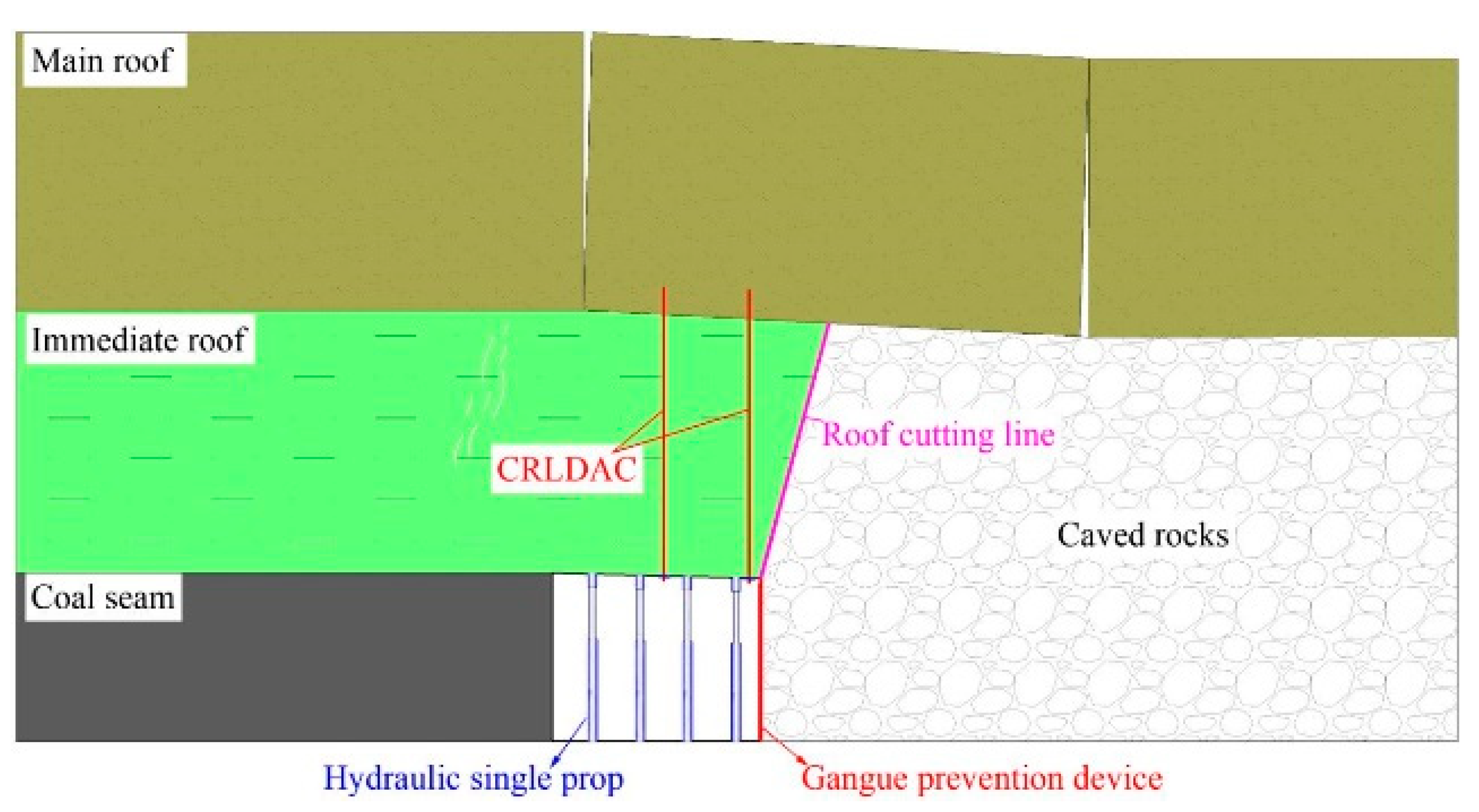


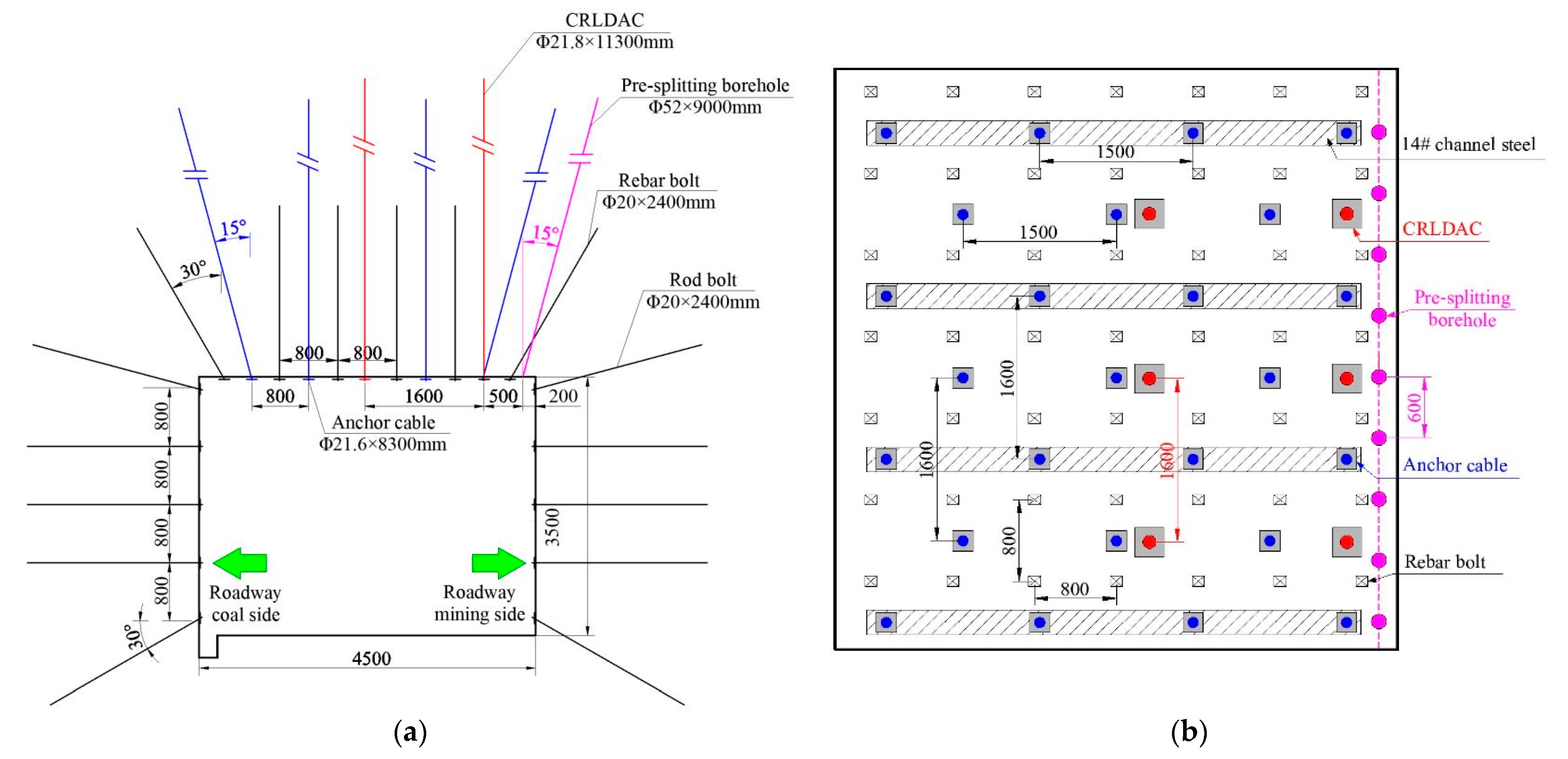




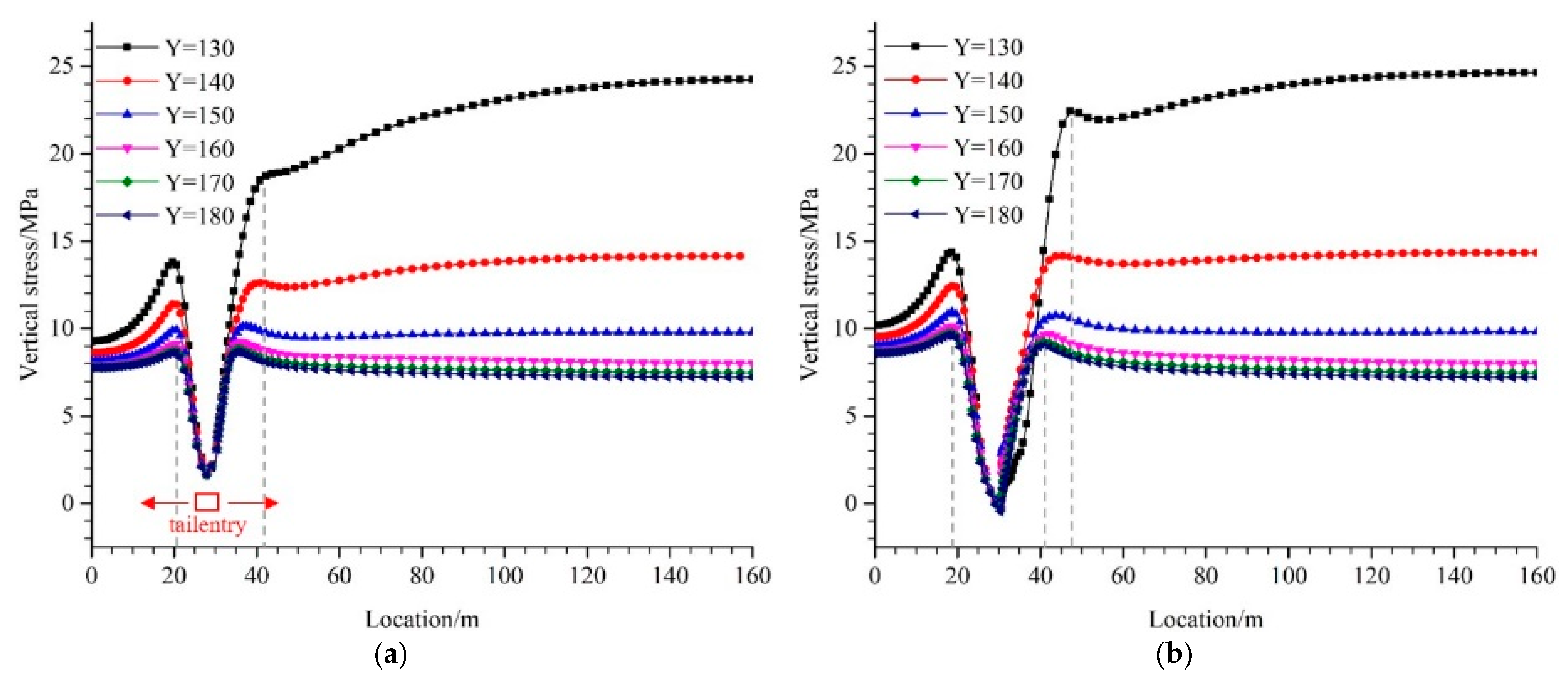
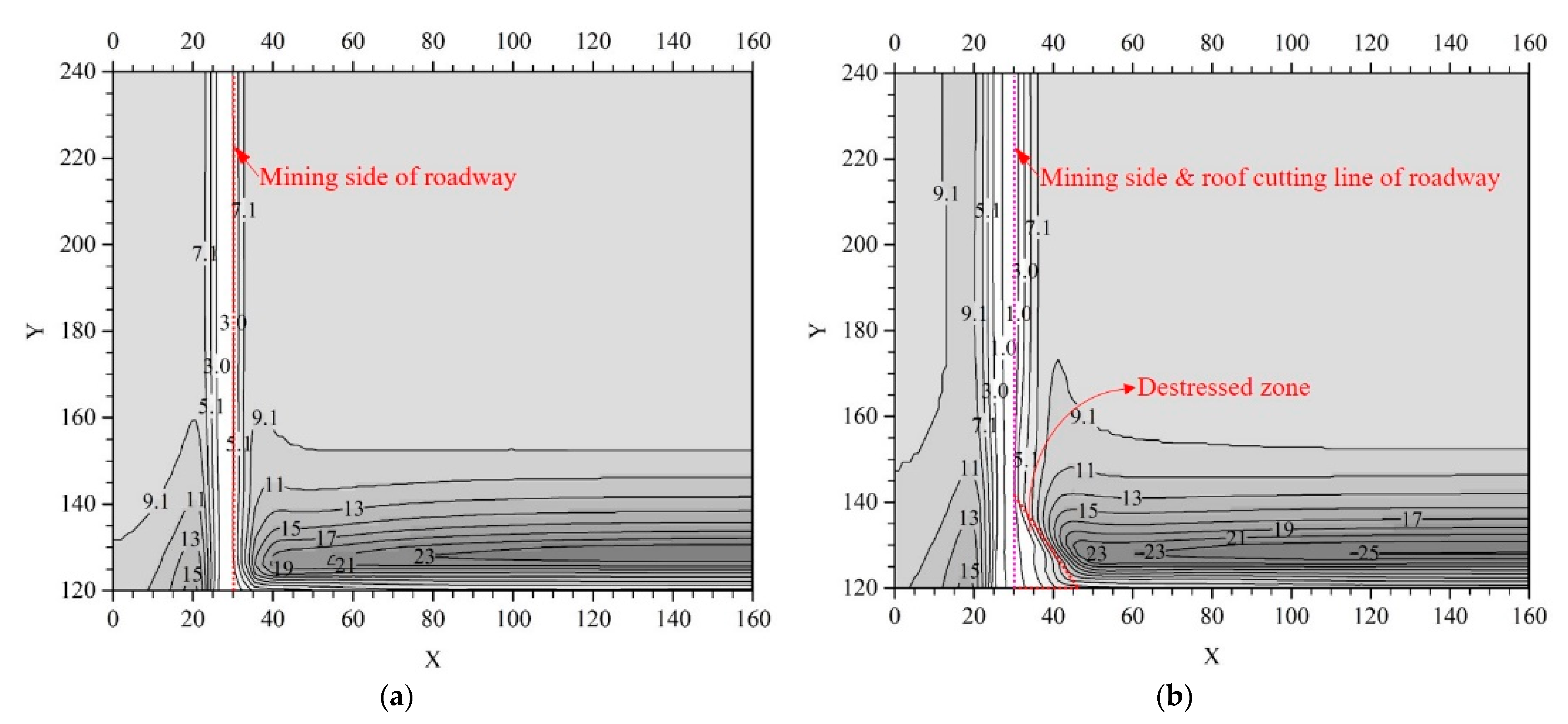
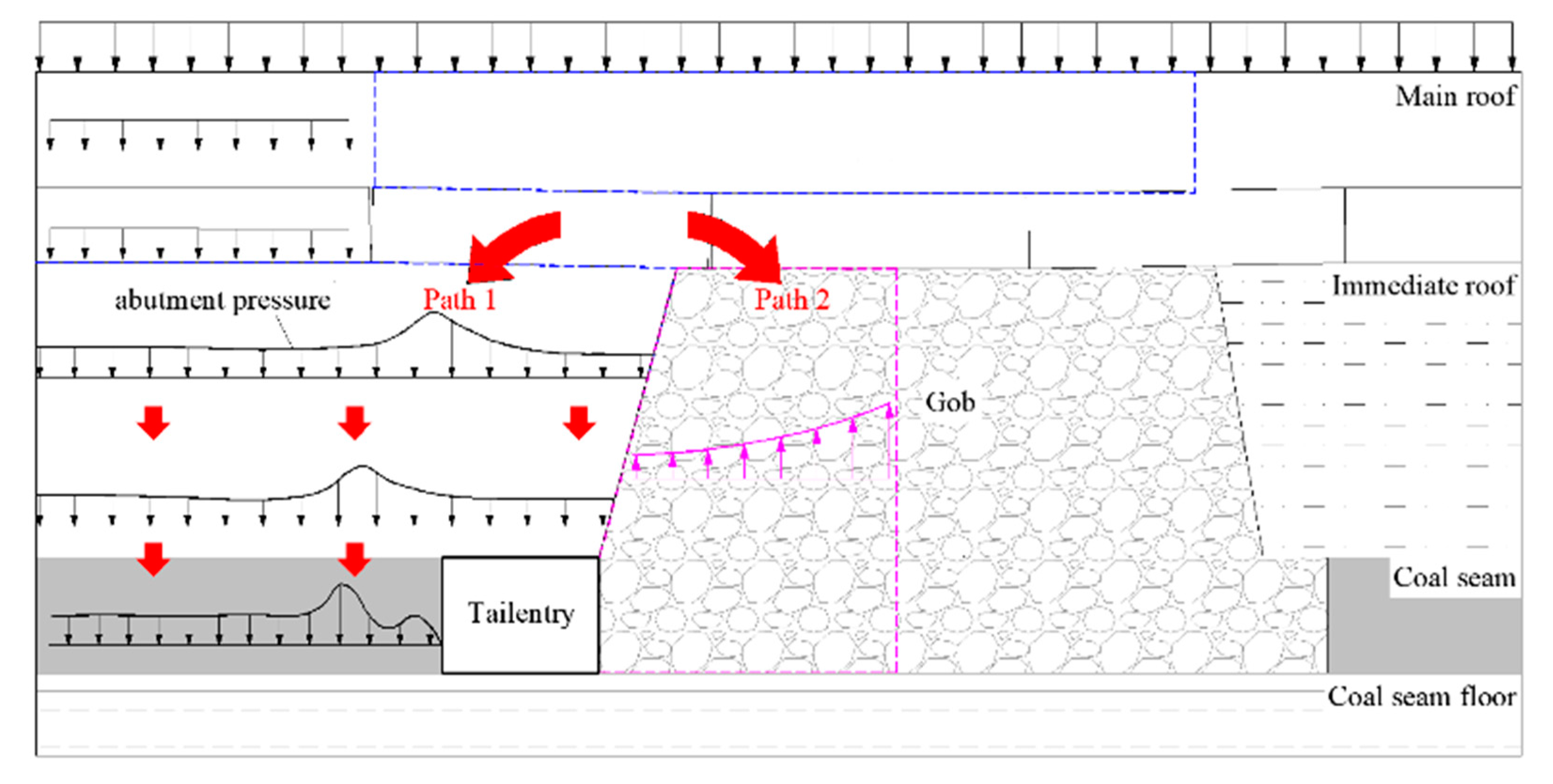

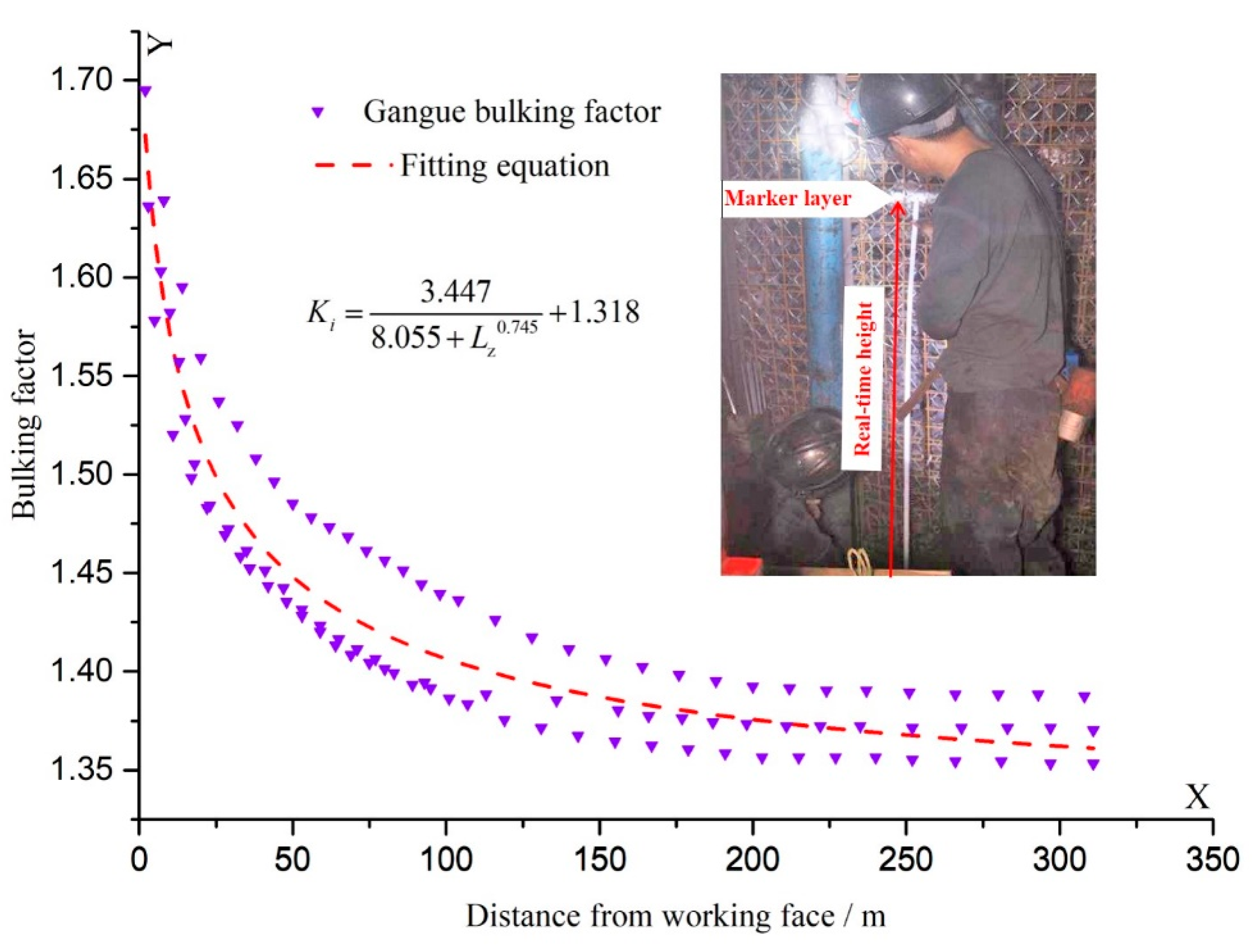

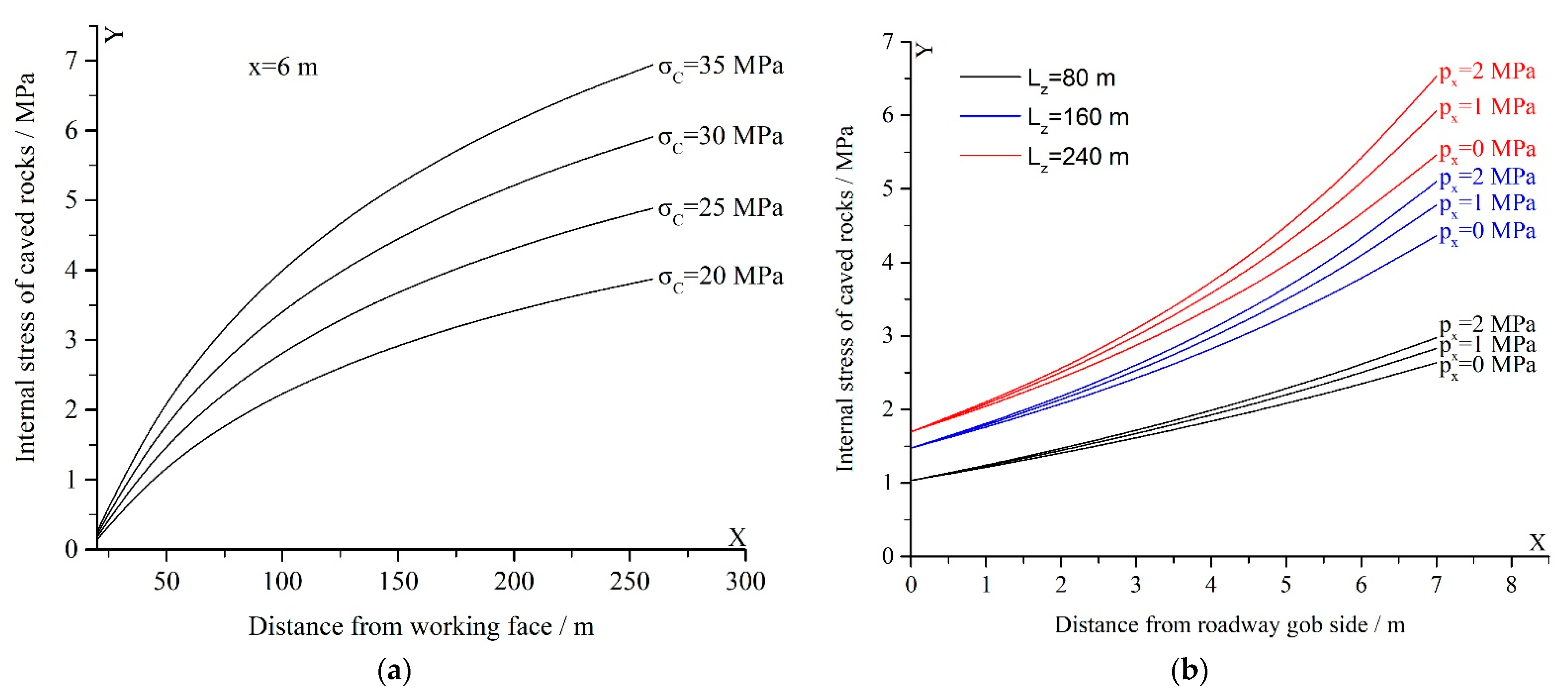
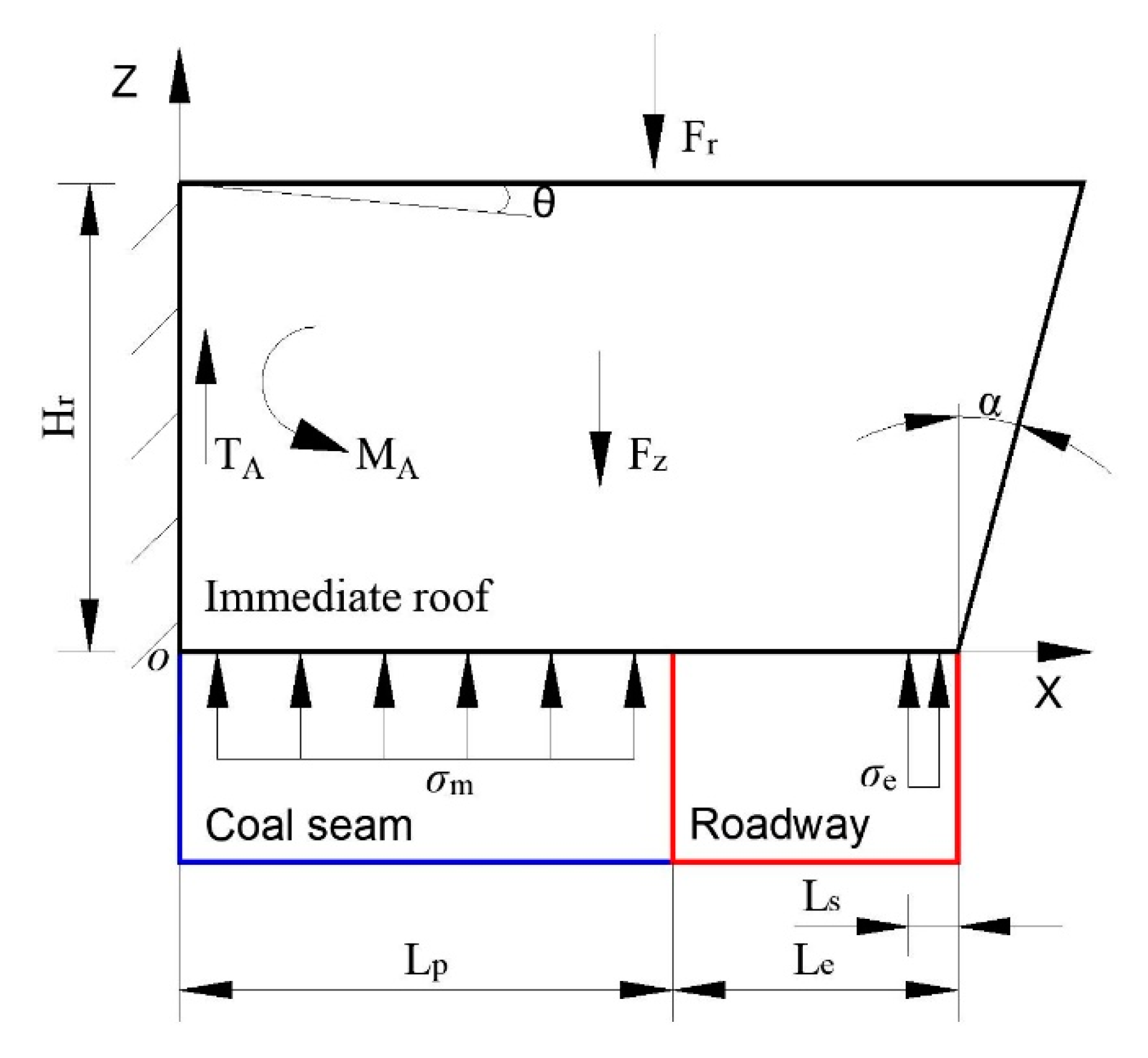


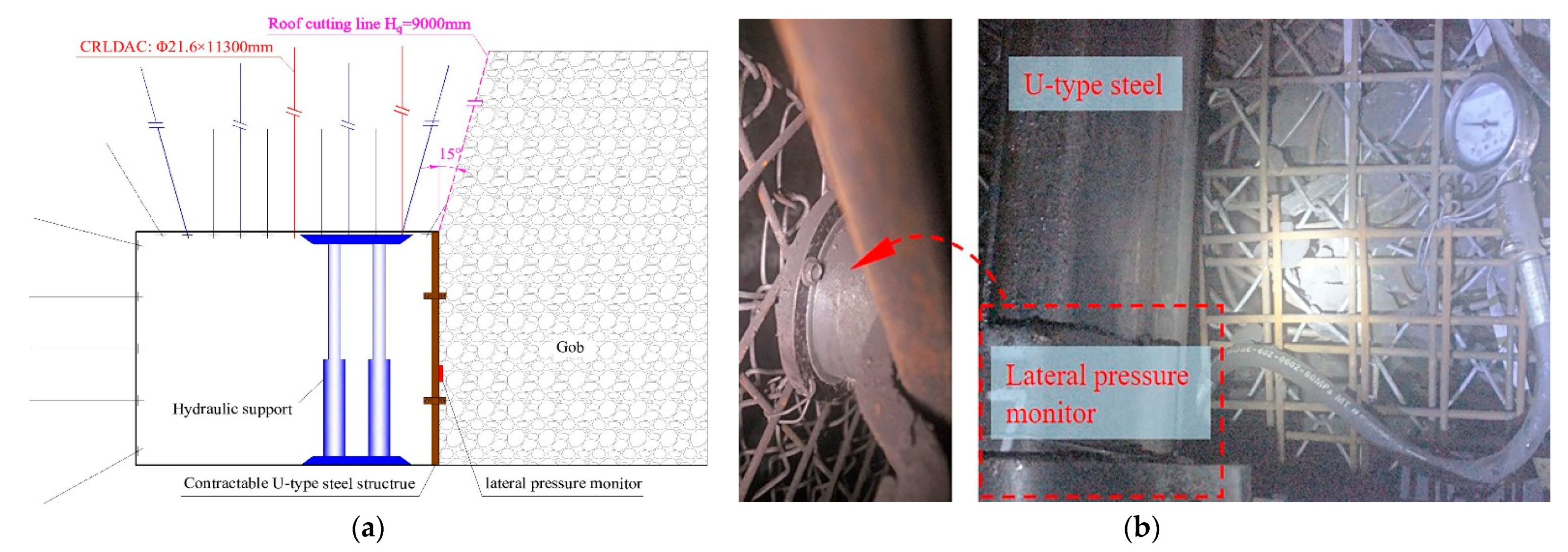

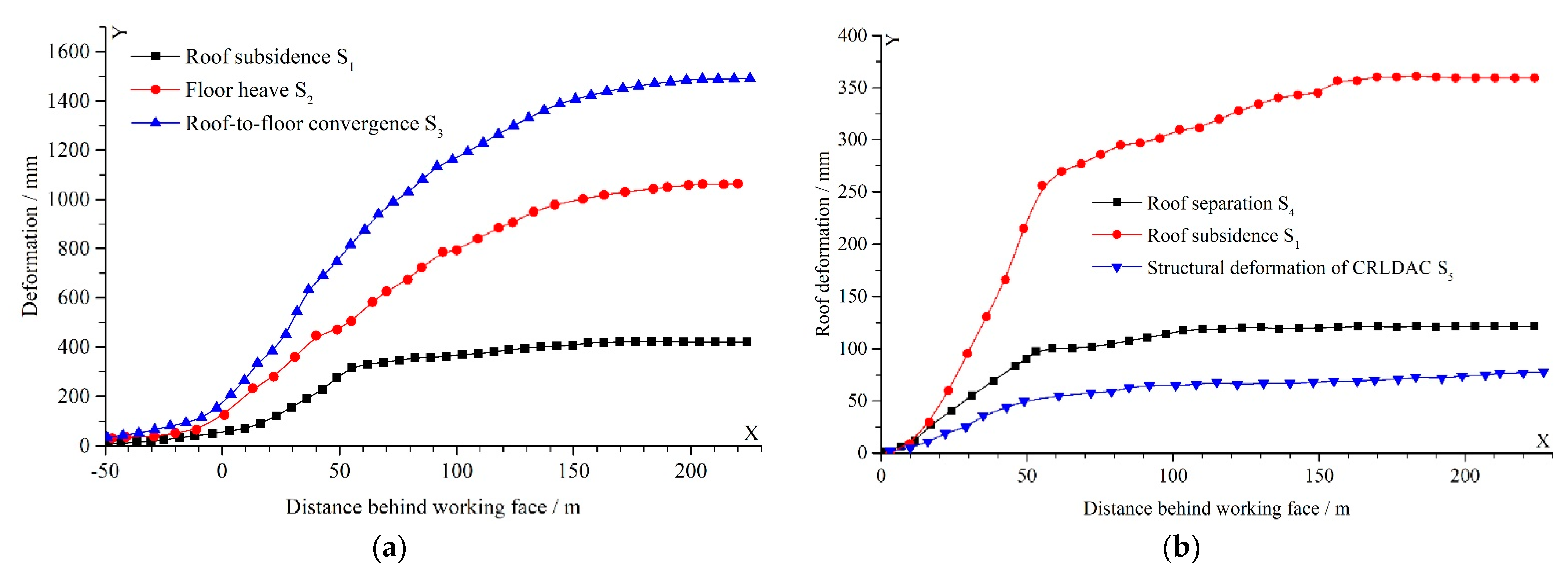
| Lithology | Density (kg/m3) | Bulk Modulus (103 MPa) | Shear Modulus (103 MPa) | Friction Angle (°) | Cohesion (MPa) | Tensile Strength (MPa) |
|---|---|---|---|---|---|---|
| Overlying strata | 2300 | 3.2 | 1.6 | 33 | 1.6 | 0.7 |
| Sandy mudstone | 2550 | 3.7 | 1.8 | 32 | 2.2 | 1.2 |
| Fine sandstone | 2430 | 2.5 | 1.7 | 30 | 2.4 | 1.4 |
| Medium sandstone | 2680 | 3.9 | 1.9 | 38 | 2.2 | 1.6 |
| Coal seam 2-1 | 1330 | 1.9 | 0.6 | 24 | 0.8 | 0.5 |
Publisher’s Note: MDPI stays neutral with regard to jurisdictional claims in published maps and institutional affiliations. |
© 2021 by the authors. Licensee MDPI, Basel, Switzerland. This article is an open access article distributed under the terms and conditions of the Creative Commons Attribution (CC BY) license (http://creativecommons.org/licenses/by/4.0/).
Share and Cite
Guo, Z.; Wang, H.; Ma, Z.; Wang, P.; Kuai, X.; Zhang, X. Research on the Transmission of Stresses by Roof Cutting near Gob Rocks. Energies 2021, 14, 1237. https://doi.org/10.3390/en14051237
Guo Z, Wang H, Ma Z, Wang P, Kuai X, Zhang X. Research on the Transmission of Stresses by Roof Cutting near Gob Rocks. Energies. 2021; 14(5):1237. https://doi.org/10.3390/en14051237
Chicago/Turabian StyleGuo, Zhibiao, Haohao Wang, Zimin Ma, Pengfei Wang, Xiaohui Kuai, and Xianzhe Zhang. 2021. "Research on the Transmission of Stresses by Roof Cutting near Gob Rocks" Energies 14, no. 5: 1237. https://doi.org/10.3390/en14051237







